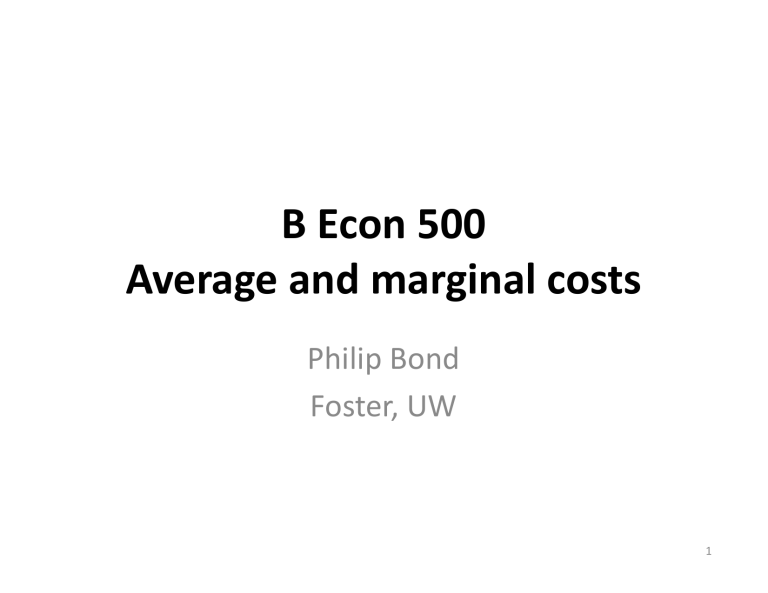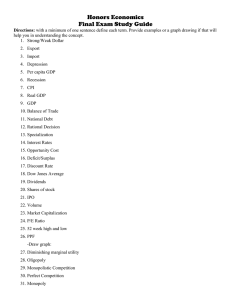
B Econ 500 Average and marginal costs Philip Bond Foster, UW 1 A few words on class overall Official name of class is: Introduction to Business Economics In practice: “Micro” Application of microeconomics to: Business decisions (esp. source of profits) Understanding broader economic trends Economics as a way of thinking about world Relative to many core classes, this class is more about giving you a way to think about the world Less about specific tools (NPV, balance sheets etc) Much of the value of economics is as a map of dangers to avoid A few words on class overall Focus on concepts and applications Minimize math (I realize people have diverse preferences) Economics is increasingly data-orientated, and is concerned with an increasingly diverse range of topics →team data assignments on early-deaths, and on gender wage-gap A few words on class overall A common critique of economics: based on humans being hyper-rational and self-interested In my view, largely misguided, though economists often don’t help themselves In this class, (mostly) avoid these assumptions Applying the material Aim: give you as much practice as possible to apply material Especially to new settings (least-exposed to AI-replacement) We’ll spend lots of class time on this Exams are relatively challenging “word problems” practice in class, and do “topic checks” Mix of assignments 10% participation/attendance each class has an in-class quiz 5% Short pre-class quizzes maximize value of in-class time; 2 attempts allowed 15% Homework quizzes help master the material 15% Longer data exercises quantitative engagement with important topics 5% Topic checks old exam questions; 2 attempts allows; more flexible deadlines 20%/30%, Exams I and II on Feb 8 and Mar 7 Questions about class overall? Detailed syllabus on Canvas Please use name tents Try to sit in same seat each class Closed laptop policy (except when required for analysis) I will bring copies of slides Today: Average and marginal costs From pre-class reading: $42M for rental + employment costs 1M customers each year $20 food+drink cost per customer Total cost (TC) = $42M + 1M*$20 = $62M Average cost (AC) of each customer=$62M/1M=$62 Marginal cost (MC) of each customer = $20 Costs defined by decision problem A general point: “Marginal” can only be understood in the context of a specific decision Serve additional customer? MC of customer Stay open an extra hour? MC per hour Open an additional location? MC of location What is the lowest price you should charge for food during happy hour? Application A city prohibits on-site dining because of health concerns Takeout will produce 30% of typical sales Should restaurant offer takeout? Typical restaurant revenue and costs Sales Expenses Food and beverage costs Labor costs Occupancy and related costs Depreciation and amortization Other costs General+admin costs $63M $62M $20M $21M $5M $2M $6M $8M From Bureau of Labor Statistics: For restaurants: kitchen staff are 1/3 of labor cost, servers 2/3 of labor cost Source: Kura Sushi, fiscal year ending August 2019 (publicly traded “microcap” stock, so accounts public) Numbers consistent with standard breakdowns of costs from industry guides, e.g. Discuss in groups of 2-4, report back Will randomly call on a couple of groups To remember ``Marginal” defined by decision Focus on costs that are a marginal for a decision Ignore fixed costs Line items such as depreciation, overhead, administration expenses are often fixed costs (Recall Kura Sushi Statement of Operations) Business plan: Movie ticket subscriptions $10/month –> subscriber can purchase unlimited movie tickets (for personal use) Market data (simplified), US movie-going population 89% attend 4 or movies/year 11% attend 18 movies/year Average ticket price in US is ≈$9 (from NATO) Market research suggests: If an individual subscribes, attends twice as many movies Assess business plan Discuss in groups of 2-4, report back Optional: A non-monetary application [Assume that] You are concerned about CO2 emissions. “cars emit 127g of CO2 per passenger per kilometre and buses 106g” Should you travel by car or bus? Summary Marginal costs are what matter for decisions Be careful not to inadvertently focus on average costs Ignore costs that are fixed and/or sunk for a particular decision Accounting entries such as overhead often contain such costs Data As mentioned, we’ll spend some of quarter looking at data Will often look at data tied to class topic But today, will look at economic growth Size of economy: GDP Gross Domestic Product (GDP) A measure of the size of the economy US: GDP » $27.5T Much easier to conceptualize in per-person terms (“per capita”) Population of US » 330M So GDP/capita » $27.5T/330M » $83K How has economy changed over time? Produce a graph of real (inflation-adjusted) GDP/capita since 1947 A very useful source: FRED (Federal Reserve Economic Data) run by Federal Reserve Bank at St Louis Life expectancy over same period Produce graph of life expectancy since 1960 (change of start date just reflects data on FRED) Let’s look at another country South Korea (Republic of Korea) GDP/capita since 1960 Life expectancy since 1960 Make sure you can do this

